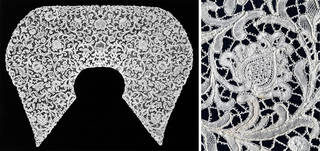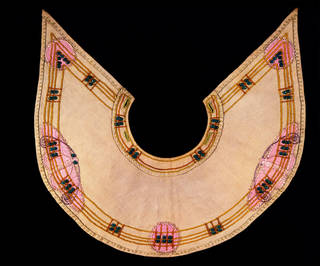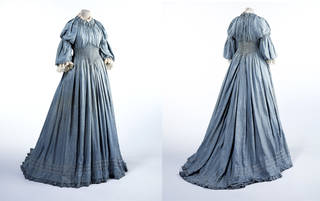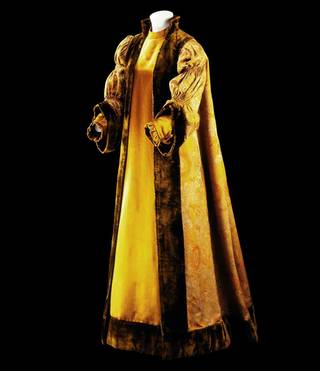What did the Arts and Crafts movement offer the world of fashion? Not only craft production, natural motifs and a new style of jewellery but also a more modern template for women's clothes.
The Arts and Crafts movement was driven more by a belief in a set of principles, than by developing a particular style. But this didn't mean that it had no influence on the world of fashion. Between the late 19th and early 20th century, Arts and Crafts practitioners produced a range of striking designs for women's garments, accessories and jewellery, as well as supporting the continuation of craft-based industries, and the development of the Dress Reform Movement.
Craft production
Supporting traditional, handmade production was a central Arts and Crafts principle. Many advocates of the Movement collaborated with rural workers to produce, for example, hand-woven rugs or rush-seat, ladder-back chairs. Many items were also produced in fabric – Lewis Foreman Day (1845 – 1910), a decorative artist and industrial designer who was a leading figure in the Arts and Crafts movement, designed pieces for production by the East Devon Cottage Lace Industry, including intricate dress collars.

Embroidery was another craft-based skill enthusiastically promoted by the Arts and Crafts community. Popularised by William Morris's standalone pieces and 'work it yourself' kits, embroidery was mainly done by women, and, increasingly in the late 19th-century, designed by them. During a period of changing attitudes to women in the arts, many female artists seized opportunities to establish themselves as working designers. These included Jessie Newbery (1864 – 1948), a Scottish artist who in 1894 established a Department of Embroidery at the Glasgow School of Art to "teach embroidery in a modern manner for use on modern garments". Newbery's intricate, geometric and contemporary-looking embroidery designs won her international acclaim, and she became an influential member of Glasgow's artistic community.

Natural motifs
The Arts and Crafts movement ushered in a more naturalistic and more British – with its fresh new focus on English gardens and hedgerows – frame of reference for pattern, which influenced the development of dress fabrics. The work of William Morris (1834 – 1896) in particular made the ornate and fanciful renderings of exotic blooms that had been fashionable in the middle of the 19th century look mannered and out of date. Many younger members of the Movement took up the theme, and the simple forms of native flowers and plants began to adorn everything from wallpaper to clothing.

Wildflowers in particular were popular motifs, as seen on a striking velvet coat produced for sale in London department store Marshall & Snelgrove. With its medieval-style collar, voluminous outline and embroidered sprays of an English wildflower called Sweet Cicely, this garment displays all the elements of the looser, historical-style dress that was fashionable in Arts and Crafts circles.

Although at first ridiculed, many of the decorative features of this form of clothing were by the 1890s absorbed into mainstream fashion. Natural motifs were also used to add decorative accents to an outfit. Mackay Hugh Baillie Scott (1865 – 1945) used floral embroidery both to decorate the soft furnishing of his interior designs, as well as his patterns for accessories, such as a shantung silk collar adorned with fronds and harebells (a 'bluebell' type wildflower).

Jewellery
Arts and Crafts jewellery designers strongly emphasised the beauty of good design, calling into question the idea of a piece's value being based on money alone. Designers such as Charles Robert Ashbee, Henry Wilson and Reginald Pearson began to create pieces that often echoed medieval styles, and that were deliberately more modest than the extravagant jewels of Victorian high society.

Arts and Crafts designers preferred fewer precious gemstones (polished into domed 'cabochons' rather than facet cut), favoured silver over gold, and used painted enamel to demonstrate that a piece was handmade. Jewellery was also the first area of Arts and Crafts design in which women received real acknowledgement, with designers including Georgie Gaskin, Carrie Copson, May Hart Partridge, Charlotte Newman and May Morris (daughter of William Morris) winning public acclaim.

Although Arts and Crafts jewellery designers wanted their handmade pieces to bring beauty into the everyday lives of ordinary people, in practice only members of the elite could afford them. Seizing an opportunity, Liberty (known for supplying artistic and unusual products) adapted Arts and Crafts designs for mass production. Archibald Knox produced a series of memorably modern-looking designs for the London store: the sinuous lines of the 'Cymric' range referenced not only Celtic forms but also those of Art Nouveau. Inspired by the success of Cymric, Charles Horner, a producer based originally in Halifax, also began to machine-manufacture jewellery that had the appearance of being handmade.

Modern templates
The Arts and Crafts movement also fed into the Dress Reform Movement, which gathered momentum in the same period: from around 1850 up until the First World War. Increasingly, Victorian opinion formers began to discuss the 'unhealthy' aspect of fashion's exaggerated silhouettes for women. Reliant on a number of layers of unforgiving undergarments – such as tight-laced corsets and heavy skirt hoops – traditional Victorian dress shapes did nothing to promote natural movement of the body. Although a few pioneering women wore early realisations of Dress Reform thinking (such as 'the bloomer', a combination of shortened skirt and pantaloon-style trousers popularised in 1851 by American feminist Amelia Bloomer), it took until the last two decades of the century for mainstream fashion to begin to actively absorb it.

Towards the end of the century, members of the Arts and Crafts movement helped society move towards less restrictive fashions by wearing silhouettes that referenced historical fashions. These 'simple' romantic styles dropped from the shoulders, took pressure off the waist and allowed the body to move far more naturally (as did un-boned 'combination' underwear). London store Liberty helped accelerate the acceptance of looser fashions for women. In 1884 its newly opened dress department began to stock less formal styles. These ranged from dresses featuring the likes of whimsical 'country' smocking to more progressive garments that borrowed the flowing outlines of Arts and Crafts fashions. Increased commercial availability had a significant effect: by the outbreak of war in 1914 most fashionable outfits for women had a far more practical silhouette.

Discover more about Arts & Crafts.


